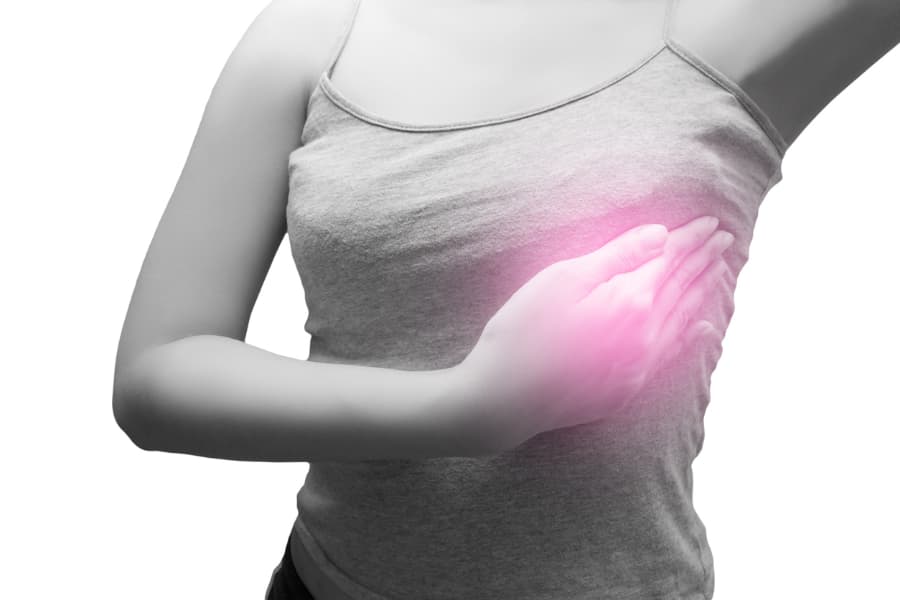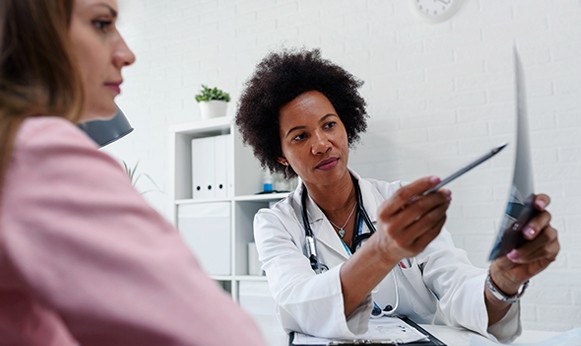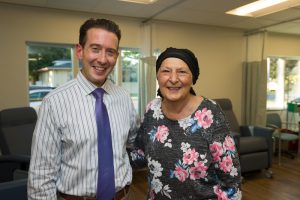
Early Signs of Inflammatory Breast Cancer
Regional Cancer Care Associates (RCCA) provides comprehensive treatment of cancer and blood disorders to patients throughout New Jersey, Connecticut, and the Washington, DC, area. Here,
HIPAA Alert: Potential Data Breach Learn More
Questions on Oncology, Hematology and/or Infusion Clinical Services due to COVID-19 Crisis – CALL 833-698-1623
Important Information for Our Patients Regarding the Coronavirus.
RCCA Providing Area Cancer Patients with Access to Care During Coronavirus Outbreak
RCCA Offering Patients Virtual Visits During Coronavirus Pandemic
Researchers and physicians have made significant strides in improving breast cancer treatments. Despite access to better techniques and technology, early detection remains the best way to ensure positive outcomes. Awareness of breast cancer symptoms is essential.
For those diagnosed with breast cancer, Regional Cancer Care Associates can help. RCCA is a group of more than 100 medical oncologists and hematologists who treat patients who have solid tumors, blood-based cancers and benign blood disorders at 25 locations throughout New Jersey, Connecticut, Massachusetts, and the Washington, DC area. They strive to educate patients while providing innovative care and cutting-edge diagnostics. Following, we discuss breast cancer symptoms and risk factors to help individuals make informed decisions regarding medical care.
Cancer is a condition caused by disordered cell growth. Normally, cells reproduce at the same rate as old cells die. This allows the cell total to remain constant. When cells become cancerous, however, they stop looking and behaving like normal cells. This includes reproducing at a much faster pace. This uncontrolled growth creates a constantly growing mass called a tumor.
Most breast cancer develops in either the lobules that produce milk or in the milk ducts, which convey milk to the nipple. If left untreated, cancer may metastasize or spread throughout the body. Lymph and blood vessels carry the abnormal cells to other organs, causing new tumors to grow.


Anybody may be diagnosed with breast cancer. Certain individuals, however, may be at greater risk than others. Some breast cancer risk factors are under the person’s control, while others are not. Major risk factors for breast cancer include:
Individuals who are at risk of breast cancer should watch their health carefully to identify early signs of a problem. The earlier symptoms are detected, the more successful the treatment will be.
It is important to note that the many women and men who experience one or more of the symptoms will not have breast cancer. Nonetheless, it is important to consult a physician about these symptoms, particularly if they are pronounced, arose suddenly, or have persisted for an extended period. Prompt evaluation will enable a doctor to address your concerns and to provide a treatment plan for whatever condition may be responsible for the symptoms.
Every case of breast cancer is unique. Some individuals experience no changes, while others may notice significant symptoms. In general, people should start by knowing how their breasts typically look and feel. Once a person is familiar with what is normal, it is easier to identify changes such as:
Breast cancer is most common in women. However, men can still develop the disease, especially if there is a family history. Breast cancer education is often lacking for men. This leads to later-stage diagnoses, as males do not always know what signs to look for. Men, especially those at risk, should watch for the following symptoms:
Not every change in the breast is caused by cancer. Breasts are commonly affected by menstruation, pregnancy, weight gain or loss, aging, or other factors. They may also be affected by one of the following non-cancerous breast conditions, which can resemble cancer:
Also called fibrocystic disease, this non-cancerous condition creates lumps of fibrous tissue. This is the same type of tissue found in scars and ligaments. It may also cause cysts, or round lumps filled with fluid. Cysts can become larger or more painful around a woman’s menstrual period.
Fibroadenomas are non-cancerous lumps of fibrous and glandular tissues found in the breast. They feel smooth, round, and solid, can be moved around easily in the breast, and are not painful. However, they may cause discomfort before or during a woman’s period.
Mastitis is an inflammatory condition caused by infection in the breast. It typically occurs due to a clogged milk duct or to breaks in the nipple skin. The infected area becomes swollen, red, and painful, and may feel warm to the touch. Mastitis also often causes fever, headache, and flu-like symptoms.
Abscesses are pockets of pus that form in the breast. They are caused by infection from lactation, breastfeeding, or mastitis. Breast abscesses are red, swollen, painful areas on the breast that may feel hot to the touch. They may also cause nipple discharge and swollen lymph nodes.
Breast self-examination involves feeling the breasts with the hands to look for unusual lumps and other symptoms of cancer. This should be done regularly. Frequent self-exams will improve a person’s familiarity with their breasts, making it easier to identify a change if one occurs. If a lump or other change is noticed, contact a physician for clinical examination.
Physicians use several methods to diagnose breast cancer. The specific approach used will depend on the symptoms, overall health condition, and any risk factors that affect the individual’s likelihood of developing cancer. Diagnostic procedures include:
During this test, the physician uses their hands to feel the breasts for lumps. This may be used to confirm the results from the individual’s self-examination or to identify symptoms of breast cancer that the person may not have noticed.
A mammogram is an X-ray device specifically designed to evaluate the breasts. The breast is gently pressed between two plates, allowing X-rays to pass through the tissue for a clear image. Diagnostic mammograms are more thorough than routine screenings.
Ultrasound imaging is sometimes used alongside mammograms. This technology uses sound waves to create an image of the breast’s internal structures and typically looks at specific areas rather than the whole breast. This provides a more detailed assessment of suspicious areas.
A biopsy involves removing a small amount of breast tissue or fluid, called a sample. The physician may use a hollow needle to take the sample, or he or she may perform a surgical procedure. The sample is then evaluated in a laboratory to help physicians learn more about the tumor’s characteristics.
Once cancer has been diagnosed and its stage has been determined, physicians may recommend the appropriate treatment. There are many approaches to treating breast cancer, including:
Breast cancer surgery is known as mastectomy. It involves cutting into the breast to remove cancerous tissues. Extensive cancer may be treated by removing the entire breast. If the person is at high risk for breast cancer recurring, a double mastectomy may be performed as a preventative measure.
Radiation therapy uses high-energy beams to kill cancer cells. It may be used on its own but is frequently used in conjunction with surgery. Following tumor removal through surgery, radiation therapy can eliminate any cancerous cells that remain.
Chemotherapy uses a strong medication to shrink or kill cancer cells. It may be administered through an intravenous line or taken orally as a pill. Chemotherapy may be used alone, or it may be used after surgery or radiotherapy to kill cancer cells that survived the previous procedure.
Hormone therapy blocks the body’s production of hormones that contribute to the growth of breast cancer, or it changes how those hormones work. This approach is not effective for all breast cancer types. For some, however, it can effectively stop cancer growth and kill the tumor.
Targeted therapy uses medications that attack specific types of cancer cells. It is a more focused method than chemotherapy and may be recommended if chemotherapy does not work. It can also be used with other treatments to ensure all breast cancer cells are destroyed. RCCA aims to use targeted therapy when possible.
Dealing with a breast cancer diagnosis can be difficult, both physically and emotionally. This is why patients with cancer should seek resources for support, including:
There are many ways in which people can reduce their risk of developing cancer. Following a healthy lifestyle with a good diet and plenty of exercise is an important step toward decreasing the likelihood of developing cancer. Quitting smoking and reducing alcohol consumption can also reduce the risk.
Individuals can also take measures to improve their chances of a successful treatment if cancer develops. The most important is early detection. Self-examination can help people identify signs of breast cancer. Regular mammogram screenings are also crucial for detecting cancer that has not yet created a noticeable lump. Consult a physician about what age is appropriate to start mammograms.
Awareness of breast cancer symptoms is crucial to ensure an early diagnosis and the best outcomes from treatment. Regional Cancer Care Associates specialists provide care to more than 30,000 new patients and 265,000 established patients each year. RCCA physicians offer patients innovative therapies, including immunotherapies and targeted therapy, cutting-edge diagnostics as well as access to approximately 300 clinical trials in community-based centers close to home.
Early signs of breast cancer can include a new lump in the breast or armpit, thickening or swelling of part of the breast, puckered or dimpled skin similar to an orange peel, or other significant changes in the breast’s appearance. Breast cancer may also cause skin irritation or a strange nipple discharge.
No. Most breast lumps are benign, meaning they are non-cancerous. Lumps may be caused by a variety of conditions including cysts, fibroadenomas, inflammation, or abscesses. Some non-cancerous conditions can be dangerous, so it’s important to get any lump checked by a healthcare provider.
Most cases of breast cancer are not painful. Some individuals, however, may experience persistent pain or discomfort. Persistent pain may also indicate a different underlying condition. Pain should always be evaluated by a healthcare provider to rule out dangerous conditions and help the individual find relief.
Breast cancer often causes skin changes, including redness, dimpling, an orange-peel texture, or a scaly or flaky texture. These signs should be assessed by a doctor.
Breast cancer can cause other symptoms, including a change in breast shape or size, changes in skin appearance, nipple discharge, or an inverted nipple. Late-stage breast cancer may also cause unexpected weight loss, bone pain, shortness of breath, and fatigue.
If you’re experiencing any of these symptoms, consult with your doctor right away. With so many different types of breast cancer, only a medical professional can rule out the disease. If you are diagnosed with breast cancer, our comprehensive, patient-centered care at Regional Cancer Care Associates will help you fight this disease. For more information, contact us today to schedule an appointment at one of our 30 locations in New Jersey or Connecticut.

Regional Cancer Care Associates (RCCA) provides comprehensive treatment of cancer and blood disorders to patients throughout New Jersey, Connecticut, and the Washington, DC, area. Here,

When people think of breast cancer, they generally think of it affecting women. However, in rare circumstances, breast cancer can affect men, most commonly in

First diagnosed with breast cancer in 1992, she has persevered in her battle against the disease for more than 30 years.

Regional Cancer Care Associates is one of fewer than 200 medical practices in the country selected to participate in the Oncology Care Model (OCM); a recent Medicare initiative aimed at improving care coordination and access to and quality of care for Medicare beneficiaries undergoing chemotherapy treatment.